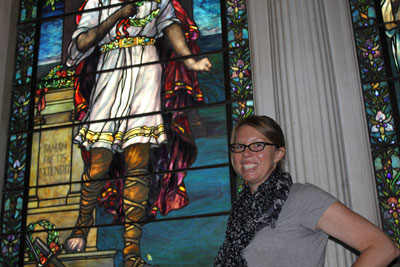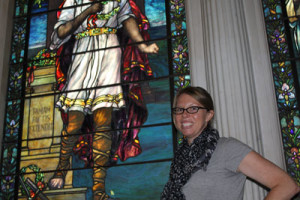Treasure Hunt: Searching for the Works of the Church Glass and Decorating Company of New York
By Amber Wingerson
Smithsonian-George Mason Program in the History of Decorative Arts
In operation between 1899 and 1913, the Church Glass and Decorating Company of New York (CGDC) manufactured a variety of stained-glass and decorative windows for churches, academic institutions, and other private and public buildings. One of several stained-glass companies that emerged during this time period, the company produced opalescent or “Tiffany-style” windows in addition to being the sole American agent for John Hardman & Company, an acclaimed English firm. Additionally, the CGDC produced ornamental windows, both stained-glass and colorless windows with intricate leading patterns, which were intended for businesses, public buildings, and private homes.
The CGDC’s history coincided with a period of remarkable growth in the number of religious congregations in American cities. This movement ignited a period of ecclesiastical building expansion, which created new markets for ecclesiastical decorations and stained-glass windows. Current scholarship on the CGDC is limited, but their stained-glass windows can be found in the same churches that commissioned windows from Tiffany Studios, John La Farge, William and Morris Company, J. & R. Lamb, and other top stained-glass producers of the early 20th century.
While I have yet to find an archival collection for the CGDC, there are two known trade catalogs naming several churches and institutions that purchased stained-glass windows and other decorations from the company. These institutions can be found from San Francisco to New York City. Thanks to the generosity of the Decorative Arts Trust, I was able to increase the geographic span of my thesis research to include more of these objects. Much of my research includes visiting church archives and local historical societies, as well as viewing the objects in order to find possible signatures and similarities to documented examples. Over the course of the summer and early fall, I had the opportunity to view and research stained-glass windows produced by the firm in Massachusetts, Rhode Island, Connecticut, and Illinois.
In the early years of the CGDC, the firm established a Chicago office and produced several stained-glass windows for buildings there, including well-known examples at the Armour Institute of Technology (now the Illinois Institute of Technology) and Second Presbyterian Church, a site included in the Trust’s upcoming symposium in Chicago. Other locations in the city had windows that were suspected to be by the CGDC but had since lost their histories, as was the case for the Church of Our Savior. The church was listed in the company’s catalog, and four unsigned windows were particularly reminiscent of other CGDC examples. During my visit, I was able to find documentation to corroborate this notion.
Other windows I visited are now locked away and rarely seen, such as at the Sisters of Mercy Chapel in Providence, Rhode Island, which is now an admissions building for Johnson & Wales University. The unused chapel contains eleven elaborate, well-preserved windows manufactured by John Hardman & Company but retailed by CGDC, a connection previously unknown.
Another exciting discovery occurred in Plymouth, Massachusetts. I learned that the archives of the town’s First Church had been donated to the Pilgrim Hall Museum and, after careful research, found a brochure produced by the CGDC about two stained-glass windows in the church. This is only the fifth publication I have found produced by the CGDC to date.
I am grateful to the Trust’s members for supporting my scholarship with this opportunity to complete this travel and research for my masters thesis.
SAVE THE DATE
- Special Symposium
“Classical Splendor”
The Philadelphia Museum of Art
November 4, 2016 - New York Antiques Weekend
January 20-21, 2017 - Spring Symposium
Savannah
April 21-24, 2017 - Spring Study Trip Abroad
Scotland
May 14-22, 2017 - Fall Symposium
Hartford & Western Connecticut
September 2017 - Fall Study Trip Abroad
Venice and the Veneto
October 9-16 and 22-29, 2017
In operation between 1899 and 1913, the Church Glass and Decorating Company of New York (CGDC) manufactured a variety of stained-glass and decorative windows for churches, academic institutions, and other private and public buildings. One of several stained-glass companies that emerged during this time period, the company produced opalescent or “Tiffany-style” windows in addition to being the sole American agent for John Hardman & Company, an acclaimed English firm. Additionally, the CGDC produced ornamental windows, both stained-glass and colorless windows with intricate leading patterns, which were intended for businesses, public buildings, and private homes.
The CGDC’s history coincided with a period of remarkable growth in the number of religious congregations in American cities. This movement ignited a period of ecclesiastical building expansion, which created new markets for ecclesiastical decorations and stained-glass windows. Current scholarship on the CGDC is limited, but their stained-glass windows can be found in the same churches that commissioned windows from Tiffany Studios, John La Farge, William and Morris Company, J. & R. Lamb, and other top stained-glass producers of the early 20th century.
While I have yet to find an archival collection for the CGDC, there are two known trade catalogs naming several churches and institutions that purchased stained-glass windows and other decorations from the company. These institutions can be found from San Francisco to New York City. Thanks to the generosity of the Decorative Arts Trust, I was able to increase the geographic span of my thesis research to include more of these objects. Much of my research includes visiting church archives and local historical societies, as well as viewing the objects in order to find possible signatures and similarities to documented examples. Over the course of the summer and early fall, I had the opportunity to view and research stained-glass windows produced by the firm in Massachusetts, Rhode Island, Connecticut, and Illinois.
In the early years of the CGDC, the firm established a Chicago office and produced several stained-glass windows for buildings there, including well-known examples at the Armour Institute of Technology (now the Illinois Institute of Technology) and Second Presbyterian Church, a site included in the Trust’s upcoming symposium in Chicago. Other locations in the city had windows that were suspected to be by the CGDC but had since lost their histories, as was the case for the Church of Our Savior. The church was listed in the company’s catalog, and four unsigned windows were particularly reminiscent of other CGDC examples. During my visit, I was able to find documentation to corroborate this notion.
Other windows I visited are now locked away and rarely seen, such as at the Sisters of Mercy Chapel in Providence, Rhode Island, which is now an admissions building for Johnson & Wales University. The unused chapel contains eleven elaborate, well-preserved windows manufactured by John Hardman & Company but retailed by CGDC, a connection previously unknown.
Another exciting discovery occurred in Plymouth, Massachusetts. I learned that the archives of the town’s First Church had been donated to the Pilgrim Hall Museum and, after careful research, found a brochure produced by the CGDC about two stained-glass windows in the church. This is only the fifth publication I have found produced by the CGDC to date.
I am grateful to the Trust’s members for supporting my scholarship with this opportunity to complete this travel and research for my masters thesis.


